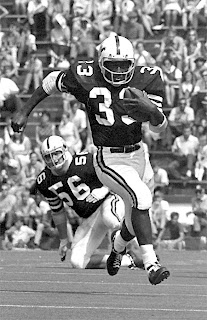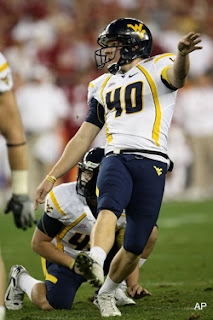Hometown: Pottstown, PA
Career: 1992-1995
Record: 28-17-2, Bowl Record: 0-2
One of the best recruits of the Don Nehlen era was Aaron
Beasley. He gave West Virginia a much needed shut-down corner to complement the
stout rush defenses of the mid-1990s. After seeing duty as a nickelback his
freshman season, he became a starting cornerback for the remainder of his WVU
career. Beasley made quarterbacks pay for throwing to his side of the field,
accumulating 19 career interception (second most in school history), taking
three of them back for scores. He collected 10 of those interceptions in 1994,
setting the school’s single season record for interceptions. Beasley would only
collect 5 interceptions as a senior as many quarterbacks elected to not throw
in his direction, leading to a well-deserved consensus All-American selection. After
a successful stint in Morgantown, Beasley went on to be one of the major
players for the expansion Jacksonville Jaguars in 1996, where he spent 6 of his
9 NFL seasons. Beasley was named to the WVU Sports Hall of Fame in 2009.
Memorable Game: One of Beasley’s interceptions for a
touchdown came in the 1994 game against Temple. The Mountaineers had begun the
1994 season with a disappointing 1-4 record. With little hope of making a bowl
game, the Mountaineers were playing loose, free of expectations. They would
rally around one another to win three of the next four games, bringing their
record to 4-5 heading into the road match-up with the Temple Owls. The
Mountaineers (as was usual in the history of this series) were heavy favorites
against the Owls. West Virginia scored early and often, embarrassing the Owls
in front of their empty stadium. Beasly picked off an errant pass late in the
game and took it back more than 60 yards for a touchdown. The interception
would be his 10th (and final) interception of his record setting
1994 campaign. WVU smashed Temple 55-17, improving their record to 5-5 on the
season, keeping their bowl hopes alive.
Competition: Beasley was the best defensive back to play for
the Mountaineers. He stills holds the school record for interceptions in a
season and second most for his career. This selection was difficult, as there
were many other well-qualified players available. I could have gone with
Garrett Ford Jr., Ray Surbaugh, or current player Ryan Clarke. Ultimately,
Beasley’s school record and All-America nod set him apart in this narrow race.
Teaser: Tomorrow we reflect on the great career of a WVU Sports
Hall of Fame running back. His career was one for the ages, although his story
if often not told with the appropriate glory. Such as with the story of Alexander
the Great; a great tale can be told in a sub-par medium. Hopefully, I will do
this player better justice than Oliver Stone did for Alexander.


















